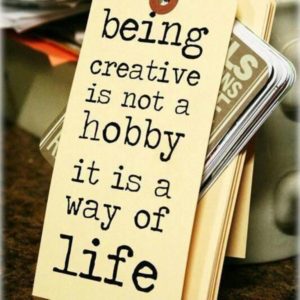Topic: Creativity
Aim: Introduce and practice vocabulary related to Creativity
Language Level: Advanced
Learner Type: Teenagers and Adults
Time: 90 minutes
Language Skills: Listening & Speaking
Materials: Creativity video, Creativity ppt, Creativity image and word cards, pens, paper, internet access, mobile devices
Digital Tool: Video
Lesson Plan
Warmer
Teacher (T) shows the first ppt slide, an image that declares, “Being creative is not a hobby, it’s a way of life.” T asks students (ss) Is the statement true? What is being creative? Do you know any creative people? T boards ss ideas.
Lead In
T tells the ss, “We will watch a short video which show 11 different images. Each image represents a word. All of the words relate to creativity. We will watch the video twice. The first time, just watch and listen. The second time, please make some notes about what you see, feel and hear.”
T asks the ss the following questions: How many times will we watch the video? (Once) Will you make the notes when we watch it for the first time? (Just watch and listen) The second time? (Make notes)
T turns off the lights and plays the video twice.
T asks ss to work in pairs or small groups and discuss, “What words do these images represent?” T monitors and notes any spoken errors.
Group feedback. T boards ss ideas about what word(s) each image represents. Group discussion comparing ss original ideas to the images from the video.
Commentary: Dramatic opening to the lesson to draw the ss attention. Clear, precise instructions for the ss to follow. T gives ss what they need (pen and paper) to avoid wasting time finding notebooks etc. T uses Instruciton Checking Questions (ICQ’s) to ensure ss know what to do.
Pre-Teach Vocabulary
T shows the first image (‘meaning’) on the ppt and says she will hand out some cards with the meanings printed on them. She holds up one set of cards, and asks the ss to read aloud what they see. After reading aloud the words, the ss select the word that best represents the first image.
T divides ss into pairs or small groups. T hands out each pair/group printed ‘image’ card(s). T then hands out each pair/group printed ‘word’ cards (with the word each image represents). T asks ss to match the image cards with the word cards. T monitors and notes down any spoken errors.
Group feedback.
T reviews spoken errors. T models the new words and drills the ss individually and chorally.
Speaking Task
T asks ss to work in pairs and report their partner’s answers to the following questions: “Are there any other words which represent creativity? How are you creative? Is being creative easy? How can we be creative in our daily lives? Group feedback. T boards ss ideas.
Listening Task
T says she will show a video entitled, What is being creative?
T asks ss to watch the video and answer the following questions: what is the main object in the video? Is it an example of being creative? How?
T shows the video. Group discussion about the following questions: What are the ideas put forward in the video about being creative? Do you agree with the advice? Is learning a language being creative? Can they use the advice in the video to help them learn a language? How?
T hands out the video transcript, and asks ss to watch the video again and fill in the gaps.
Group feedback.
(Making something new, different, of value, telling a story, your story, expressing yourself, that makes you smile, if they agree with the advice in the video. Its being passionate, creating something other people can use, take risks, don’t be afraid to make mistakes, its only from the mistakes that we learn. It’s only from the mistakes that the really interesting things happen. We may not always create or invent, but we always learn when we try.)
Creative Task
– Outline 3 ways that being creative can help you improve your language skills
– Use mobile devices to find images that represent your ideas.
– Use mobile devices to access the following digital tools for making short videos and record audio: nutshell app, Powerpoint, knovio, screencast-o-matic, capzles, glogster, Prezi etc. T & ss check which wesbites and free apps are accessible in China. Ss share their findings with the class.
Homework
T tell ss their homework is to make make a short video about creativity. T asks ss to make a short video clip outlining 3 creative ways students can improve their language skills. Ss are free to choose their own digital tool, use images, record themselves and/or record audio. T asks ss to email the presentations to her or upload to Youku.com, and they will be shown at the next class.
Why use video presentation tools?
The popularity of cameras on phones, and self-sticks highlight how much we are now living in a visual world. Pictures and images are alternative ways of presenting information, and videos allow us to mix images, audio and text all at the same time. In this way teachers can satisfy the needs of different types of learners.
Extra Resources
Teaching English, Creativity is Great lesson plan and materials
Ed Tech Web 2.0 Tools for Educations and Students
Ed Tech Tool Box: Web 2.0 by task

